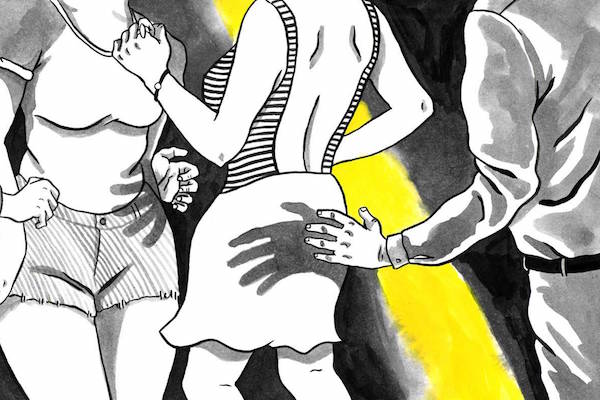A few months ago, I was at a queer party with a bunch of friends. It was a pretty busy night, so we did quite a lot of sweaty dancing and strategic maneuvering through the crowds. During one of my water (and vodka) breaks at the bar, a friend came up to me to mention how someone we both knew had been fondled and subsequently verbally harassed by a group of men just moments before. She had said something to my friend, but she didn’t feel comfortable bringing attention to herself or the situation in such a public place. I put down my drink, bee-lined it to the party host, and told her about the incident. She immediately asked me to identify the perpetrators and recruited security to help her with the situation. I watched this 90-pound girl in five-inch heels grab the man by the back of his collar and kick him out of her party. Hell yes!
This is only one of several times I have witnessed sexual harassment recently. What makes this instance different is the way in which it was handled. Had this been at any other event or establishment, I wouldn’t have been nearly as confident that the incident would’ve been handled in the same manner. For me, this distinction is what it means to be in a safe space.
Safe from what? Not just sexual harassment or violence, albeit that is a major component. But also from homophobia, xenophobia, racism, sexism… the list goes on. Now let me clarify: there is absolutely no guarantee of safety in any space, unfortunately. For me, what makes somewhere a safe space is the guarantee that any actions reflecting power-based aggression will be adjudicated. This is particularly consequential for marginalized populations (e.g. the queer community), which face discrimination at higher rates than the general public.
What makes creating and promoting these spaces tricky is defining and working toward a broad and constantly evolving ideal. Jessica Raven, executive director of Collective Action for Safe Spaces (CASS), works tirelessly on just this: “While CASS doesn’t have its own set definition for a safe space, and we know that safe spaces look different for different people at different points in their lives, we aim to build a community free from violence, where everyone feels responsible for speaking out against harassment,” she says.
CASS works in the D.C. area to make public spaces safe for everyone through advocacy, awareness, arts activism, and training. “Though we started out with a focus on sexual and gender-based harassment on the street and on public transit,” Raven reflects, “we’ve recognized that we can’t stop violence against those who are most marginalized without also working to address the many layers of oppression that they face, including racism, transphobia, ableism, Islamophobia, and many more factors.”
As a woman identifying along the queer spectrum, this ideal is incredibly important to me. In my own experience, it is difficult to find public places where I feel like I can fully express my true identity. That doesn’t apply just to displays of same-sex affection or attraction (to which I am completely entitled), but also to merely existing in a bar as a woman. Unwanted advances, lingering eyes, comments as we walk past a group of people—women build up steel-clad set armor (and ear muffs) that we wear everywhere, always. It has become part of our culture to be expected to buck up and withstand misogyny, sexism, racism, you name it. I could go on, but for the sake of my own sanity and yours, I’ll just say this: my armor gets pretty damn heavy after a while.
Every person’s armor looks different, shaped by their identity and experience. We carry our armor in different ways. I am certainly not the only queer woman who has felt a similar burden at one time or another, but my reality and need for safe space is my own. I find safety in queer parties, surrounded by my community. They provide an area where I can truly express myself in whatever way I feel. Femme for the night? Werk it girl. Feeling more center? Boi’s gotta love the snapback. Somewhere in between? Do you, boo boo. I am welcomed and celebrated in these places. If I were ever to feel otherwise, I know a 90-pound girl who will drag some people out by the collar.
People and places cannot guarantee safety. So why are safe spaces, and the practice of creating them, so important to a community such as ours? What’s the point?
“Equipping more community members to intervene helps us to promote the cultural norms that violence will not be tolerated in our communities and that it’s on everyone to keep our community safe,” says Raven.
This shift in culture also shifts responsibility in some pretty consequential ways. It’s got me thinking of what my responsibility is to my community. As someone who organizes events for queer women, I must evaluate what I can and cannot promise, practice, and promote during my parties. But for me, it’s so much more than that. Safe spaces are created by the people who occupy them—not just the organizers, but the community members too.
This may seem like a given to some people, but discrimination does not only live outside the queer scene. Safe spaces are challenged by bias within our own community as well, be it racism, biphobia, transphobia, ableism, and so forth. Our responsibility to create safe spaces must be intersectional, or else we’ve failed ourselves already.
Now it is on us to respect, create, and promote the cultural shift towards making queer spaces, and all spaces, safer.
Let’s get to work.


